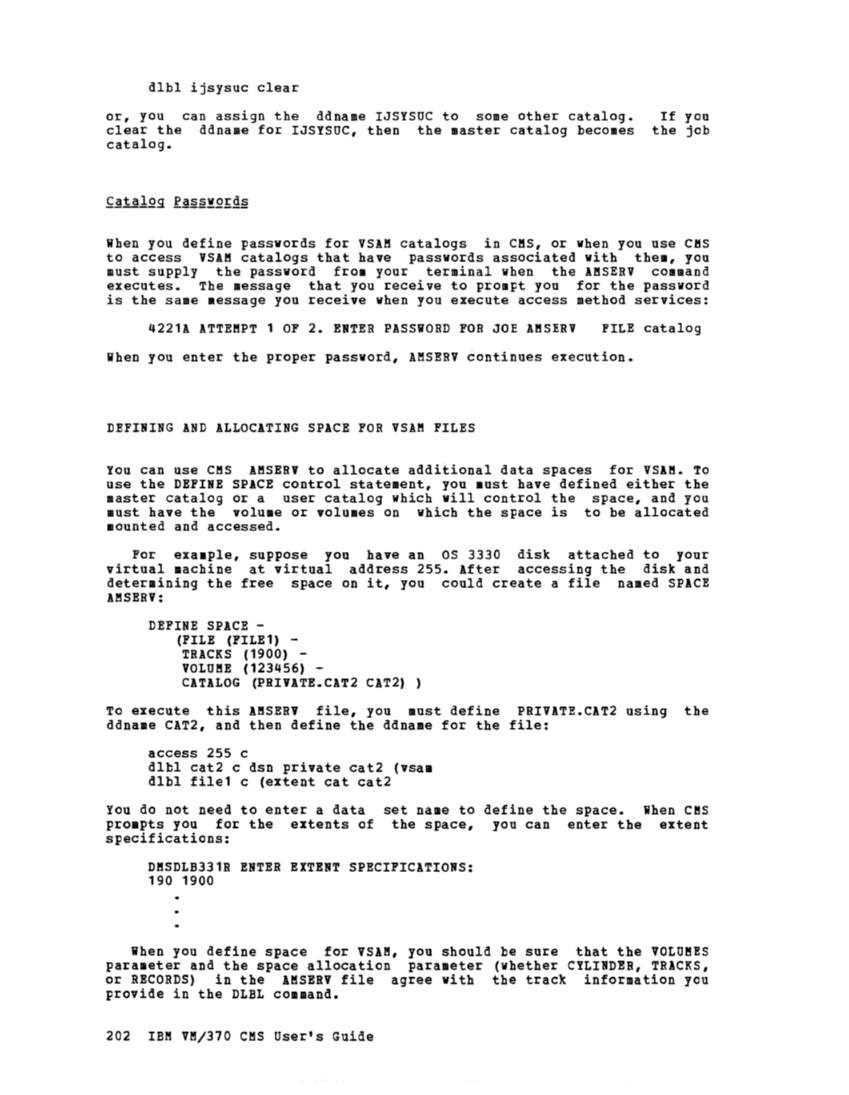dlbl ijsysuc clear
or, you can assign the ddnameIJSYSUC to some other catalog.
clear the ddname forIJSYSUC, then the master catalog becomes
catalog.
If you
the jobWhen you define passwords for VSAM catalogs in CMS, or when you use CMS to access VSAM catalogs that have passwords associated with them, you
must supply the passwordfrom your terminal when the AMSERV command
executes. The message that you receive toprompt you for the password
is the same message you receive when you execute access method services:
4221AATTEMPT 1 OF 2. ENTER PASSWORD FOR JOE AMSERV FILE catalog When you enter the proper password, AMSERV continues execution.
DEFINING AND ALLOCATINGSPACE FOR VSAM FILES You can use CMS AMSERV to allocate additional data spaces for VSAM. To
use the DEFINESPACE control statement, you must have defined either the
master catalog or a user catalog which will control the space, and you
must have the volume or volumes on which the space is to be allocatedmounted and accessed.
For example, suppose you have anOS 3330 disk attached to your
virtual machine at virtual address 255. After accessing the disk and
determining the free space on it, you could create a file namedSPACE AMSERV: DEFINE SPACE -
(FILE (FILE1) -TRACKS (1900) - VOLUME (123456) - CATALOG (PRIVATE.CAT2 CAT2) )
To execute thisAMSERV file, you must define PRIVATE.CAT2 using the
ddname CAT2, and then define the ddname for the file:
access 255 c
dlbl cat2 c dsn private cat2 {vsam
dlbl file1 c (extent cat cat2You do not need to enter a data prompts you for the extents of
specifications:
set name to define the space.When CMS the space, you can enter the extent DMSDLB331R ENTER EXTENT SPECIFICATIONS: 190 1900 When you define space for VSAM, you should be sure that the VOLUMES parameter and the space allocation parameter (whether CYLINDER, TRACKS, or RECORDS) in the AMSERV file agree with the track information you
provide in the DLBL command.202 IBM VM/370 CMS User's Guide
or, you can assign the ddname
clear the ddname for
catalog.
If you
the job
must supply the password
executes. The message that you receive to
is the same message you receive when you execute access method services:
4221A
DEFINING AND ALLOCATING
use the DEFINE
master catalog or a user catalog which will control the space, and you
must have the volume or volumes on which the space is to be allocated
For example, suppose you have an
virtual machine at virtual address 255. After accessing the disk and
determining the free space on it, you could create a file named
(FILE (FILE1) -
To execute this
ddname CAT2, and then define the ddname for the file:
access 255 c
dlbl cat2 c dsn private cat2 {vsam
dlbl file1 c (extent cat cat2
specifications:
set name to define the space.
provide in the DLBL command.














































































































































































































































































































































































































































































































